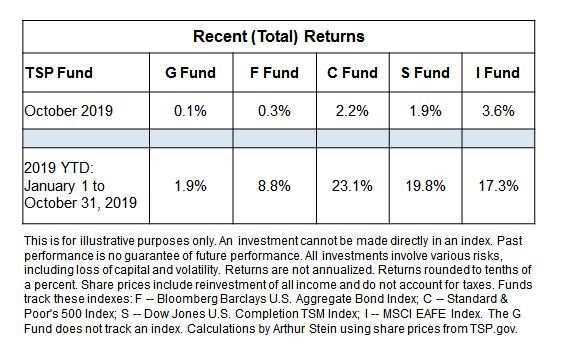
Bear market: Are you ready?
This is the longest bull market in history. But eventually it will change, the market will tank.
For the past decade — since the end of the 2008-2009 Great Recession — stock market experts have regularly predicted a major correction, a drop of 20% or more in the stock market, each year up to and including now.
So far they’ve all been wrong. This is the longest bull market in history. But eventually they will be correct and the market will tank. Then all their sky-is-falling-in predictions will be filed away and forgotten.
In the meantime there is a bear market. The C, S and I funds of the Thrift Savings Plan tank. Like last time hundreds of thousands of TSP investors, both active and retired, will trade in their shares of the stock index funds for the “safety” of the Treasury securities G fund. Then what, are you ready?
Which is why we called in Arthur Stein, a Washington, D.C.-area financial planner. Many of his clients are federal workers or retirees. Several are also TSP millionaires who rode out past financial ups and downs, investing mostly or exclusively in the stock market during good times — and especially “bad” times when stocks were on sale.
He also worked on Capitol Hill and has been called back to give talks on the TSP to congressional staffers. And he’s our guest today on Your Turn at 10 a.m. EST. Listen on www.federalnewsnetwork.com and also on 1500 AM in the Washington area. The show will be archived on our website so you can listen anytime and tell a friend about it. If you have questions for him please email them before showtime to mcausey@federalnewsnetwork.com
In the meantime, here’s a guest column outlining today’s show:
Bulls, bears and the TSP
October was another positive month for the TSP. All funds increased in value and year to date returns have been excellent.
Many TSP participants are worried about when the current bull market will become a bear market. “Bull market” and “bear market” are common financial terms. A bear market is a 20% or greater loss from a previous stock market high. A bull market is a 20% or greater gain from a previous stock market low.
The 2007-2009 bear market was the worst since the end of World War II. The C fund share price (which mirrors the S&P 500 Index of large US stocks) peaked Oct. 9, 2007, and then fell 55%, reaching its lowest point on March 9, 2009.
After the March 2009 low, the S&P 500 Index began its longest continuous increase in history. As in, the longest bull market. The C fund share price recovered to its previous high of March 26, 2012, and has continued to increase over time. Stock fund investors were rewarded for their patience.
However, we are very overdue for a bear market. Here are some possible steps you may want to consider:
- Prepare mentally. Bear markets are normal but unpleasant events. If you acknowledge a bear market is coming, it may not seem so scary when it arrives.
- Prepare financially. Review your TSP account and other investments. Because of the large increases in stock market return, your percentage allocation to the stock funds may be higher than your goal. If so, reallocate some of your stock investments to the bond funds.
- Have a strategy. Possible strategies include:
- Ride it out. Maintain current TSP allocations and contributions now and when the bear market occurs.
- React to the bear market. After it occurs, move money from the bond funds to stock funds to return to your stock/bond allocation goal.
- Try to time the markets (not suggested by this author). Transfer from stock funds to bond funds when you think stock markets have peaked. Reinvest in stocks when you think the market is at or near the bottom.
- Consider your work situation.
- Current employees who are more than five years from retirement should continue stock fund contributions during the bear market (buying when prices are low).
- Retirees should not leave themselves in a position where they would need to sell stock funds (C, S and I) for needed cash.
- Increase bank account balances to minimize the need to withdraw from the TSP and other investments.
Now – when the markets are still doing well — might be a good time to sell some stock funds to generate cash needed for withdrawals in the next 1-5 years.
The current bull markets won’t last forever but predicting the beginning of the bear market is difficult. Some commentators predict a bear market every year and one year they will be right. Like a stopped clock that is right twice a day.
Please keep in mind that past performance is no guarantee of future performance. This article is for educational purposes only and should not be taken as individual advice. Consult an appropriate professional before taking any actions. TSP funds, except for G, are not guaranteed in any way by the US government or anyone else, fluctuate in value and there will always be times when they lose value.
Nearly Useless Factoid
By Amelia Brust
The color of a chicken’s egg can generally be determined by the color of their earlobes. The earlobes are not easily spotted because they are hidden beneath a layer of feathers, but their color varies by breed and ranges from white to nearly black. Chickens with white earlobes lay white eggs exclusively while birds with dark lobes lay brown eggs. Araucana chickens may have earlobes that are a pale green or blue color.
Source: McGill University
Copyright © 2024 Federal News Network. All rights reserved. This website is not intended for users located within the European Economic Area.
Mike Causey is senior correspondent for Federal News Network and writes his daily Federal Report column on federal employees’ pay, benefits and retirement.
Follow @mcauseyWFED







